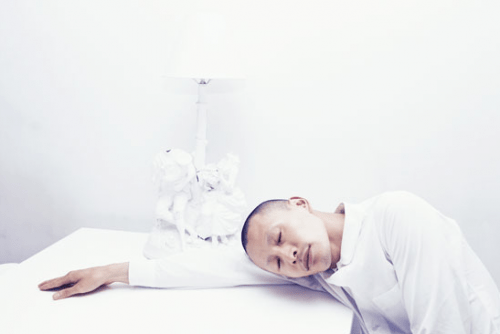
The Asia Song Society, Terence Koh’s notorious, Factory-esque three-storey art gallery-cum-studio-cum-living space is almost entirely packed up the day The Block arrives to photograph the New York-based, Canada-raised art provocateur. He’s in the process of relocating from the Lower East Side to Chinatown, “where the snow fairies are,” he says, in the typically cryptic, frequently bizarre, yet good-natured way anybody familiar with Koh is used to him communicating. “I feel comfortable living amongst my people.”
Though Koh can be enigmatic, he’s also very cooperative, and is noticeably pleased to work with a magazine that’s Canadian. In response to my question about whether he’d ever consider moving to L.A., where a lot of the art world’s focus seems to be shifting, he declares that he can only fathom living in New York or Vancouver (where he went to art school at Emily Carr: “I remember when you get off the airplane how fresh and crisp the air always is and how kind the hearts of the spirits are there,” he says). He won’t tell me which fashion designers he loves at the moment, only saying, “Canadian designers have a special loving touch.” It might be pandering, but it’s flattering nonetheless.
Koh’s come a long way from Vancouver art school student to New York art world darling, and he’s known almost as much for his flamboyant lifestyle (he once proclaimed himself “The Naomi Campbell of the art world”), fashion choices (all-white designer ensembles, frequently topped off with his infamous monkey-fur coat), and celebrity friends (Lady Gaga), as he is for his daring, experimental, frequently pornographic and — let’s not forget — expensive art (he once sold his own gold-plated feces for $500,000). But these days, Koh appears to have entered a period of self-restraint. After the photo shoot, he explains to me via email (his refusal to talk on the phone is well-known; in this case, he tells me that he doesn’t even own one after throwing it into the East River several months ago), “I am in archival mode, so that all I have in my closet is two pairs of pants, two pairs of shirts, two jackets, two T-shirts, two sweaters and two pairs of underwear. Everyting else goes into storage. I am trying to simplify life choices as much as possible.” A few days later, images of a Terence Koh estate sale, featuring a table of white bunny and cat sculptures, polished leather shoes, rubber duckies, and a rack full of white furs, show up on Twitter. Koh wasn’t kidding about scaling down.
Not that his living space was ever cluttered. The A.S.S. is immaculate. It’s all white at every level, complete with white walls, white floors, white art, and even two white cats, Gilbert and Hans-Maya, whom Koh has doted on for 12 and 6 years, respectively. (Koh’s graphic designer husband, Garrick Gott, also lives on-site.) The place is effectively hermetically sealed. Koh has blocked out sunshine with white-out curtains, explaining, if you can really call it an explanation, “Sometimes I tink I am a vampire and I can feel the light burning the iridescent skin cells on my surface.” In this environment, even the tiniest speck of dirt would show. I ask him how he manages to keep the place clean. “With discipline and precision and need. The first ting I do when I wake up after brushing my teeth is get down on my knees with a paper towel and a natural spray cleaner and clean all the spots left on surfaces. This is repeated once more in the afternoon and again at midnight.” When I comment that there’s something monklike about this kind of ritualistic, self-effacing behaviour, he goes into further detail: “I am reading this book, Peace Is Every Step, by Thich Nhat Hanh, and it made me appreciate that cleaning is a source of happiness in yourself. This is wonderful, because cleaning is no longer a means to finish a chore, but a celebration of dirt and water and hands and soap bubbles coming together as one in our universe.” And then, a typical Koh-ism: “A cup in a saucer is much as a saucer in a cup even in a The Block magazine soap bubble.”